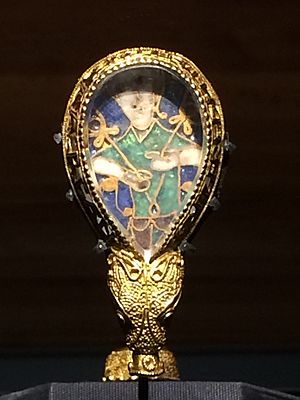Alfred Jewel facts for kids
The Alfred Jewel is a small, very old and special object made of gold, colorful enamel, and clear quartz. It was found way back in 1693 in a place called North Petherton, in Somerset, England. Today, it's one of the most popular things to see at the Ashmolean Museum in Oxford. This amazing jewel is named after King Alfred, who was a very famous king of the Anglo-Saxon kingdom of Wessex a long, long time ago.
Contents
What is the Alfred Jewel?
The Alfred Jewel is a unique piece of art from the Anglo-Saxon period. It's about 6.8 cm (2.7 inches) long. The main part of the jewel is a teardrop-shaped piece of clear quartz. Underneath this quartz is a colorful picture made of enamel. This picture shows a person, possibly Jesus or a saint, holding two flower-like objects.
What is it Made Of?
The jewel is mostly made of gold, which was a very valuable material even back then.
- Gold: The outer frame and the back of the jewel are made of pure gold. The gold frame has a detailed design.
- Enamel: The colorful picture under the quartz is made using a technique called cloisonné enamel. This means tiny gold wires were used to create small compartments, which were then filled with colored glass paste and heated until they melted and became smooth.
- Quartz: A polished piece of rock crystal, which is a type of quartz, covers and protects the enamel picture.
What Was it Used For?
Historians believe the Alfred Jewel was probably the fancy end-piece of a "pointing stick" or "aestel." These sticks were used to follow along the lines of a book while reading. This would have been very useful for someone important, like a king, who might have been studying valuable manuscripts.
Who Was King Alfred the Great?
The jewel is named after King Alfred the Great, who ruled the Anglo-Saxon kingdom of Wessex from 871 to 899 AD. He was a very important figure in English history.
Alfred's Fight for His Kingdom
King Alfred is famous for defending his kingdom against Viking invaders. He fought many battles and eventually managed to push the Vikings back. His efforts helped to unite different parts of England.
Alfred and Learning
Alfred was also a great supporter of education and learning. He encouraged people to read and translate important books from Latin into Old English, the language spoken at the time. He even wrote some books himself! It's thought that the Alfred Jewel might have been part of a set of these pointing sticks that King Alfred sent out with copies of books to different churches.
Where Was it Found?
The Alfred Jewel was discovered by accident in 1693. A man found it in a field in North Petherton, Somerset, England. It's amazing that such a small and valuable object survived for so many centuries hidden underground!
Its Journey to the Museum
After its discovery, the jewel passed through several owners. Eventually, it was given to the University of Oxford. Today, it is proudly displayed at the Ashmolean Museum, where millions of people can see this incredible piece of history. It helps us understand more about the Anglo-Saxon period and the life of King Alfred.
Images for kids
See also
 In Spanish: Joya de Alfredo para niños
In Spanish: Joya de Alfredo para niños





